How this Singaporean homeowner transformed a 1,818 sq ft maisonette condo
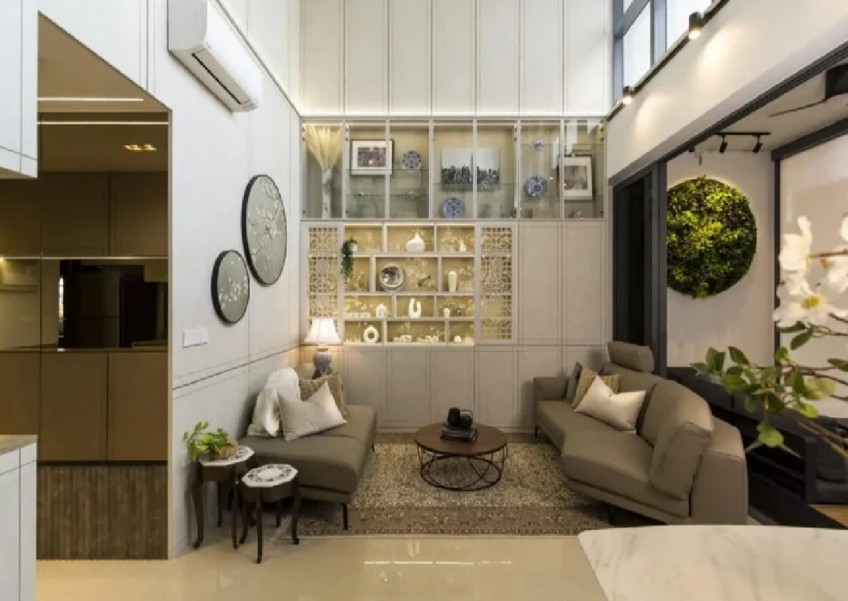

High-ceiling, double-volume units hold a fascination for many homeowners. It's impressive, gives a sense of space, and has twice the impact in Singapore. Huge homes aren't exactly the norm here, and going double volume is a major flex. But it also presents some design challenges, and this week we looked at how a homeowner with an unusual unit at The Gazania used it to good effect:
The unit is a rarity in the current age of shrinking units: a 1,818 sq. ft. maisonette with a double-volume living and dining area. This fifth-floor unit is at the top of the block, with three bedrooms on the first floor (one ensuite), and another on the second floor. There's also a kitchen with a service yard and a small additional living space upstairs.
While the owners loved the sense of spaciousness from the double-volume layout, they were also aware of the accompanying challenges. Spaces such as these are ideal for a chandelier, for example; but there are practical difficulties in climbing up to maintain it. Within a double-volume unit, you run the risk of some things being higher than the typical ladder can reach.
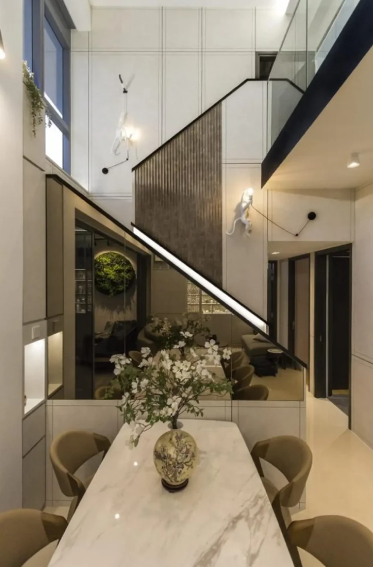
Typically, you'd need to call in a professional who can put up scaffolding to reach the lights, or electrical issues on the high ceiling; and that's not something most people want to do for just a busted light bulb.
So working with the designer, the owners sought a balance: something simple enough to stay practical, but not so simplistic that it doesn't take advantage of the apartment's best features.
The owners describe the theme as Modern Chinoiserie. This isn't Chinese in the traditional sense, but rather a European take on Chinese styles. The owners appreciate the delicate and detailed motifs - characteristic of Chinese furniture - combined with a more contemporary vibe.
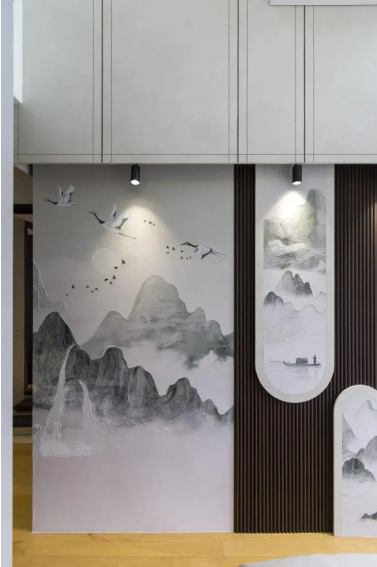
The theme is applied throughout the home; so while each room is given a character of its own, there's still a sense of harmony in the overall design. The owners were influenced by hotels they had stayed in before, and their small collection of teapots fit the theme well (plus they even ordered some Chinese kitchenware to match).
When picking furnishings, a degree of careful curation was needed. There's always a temptation to "overload" big, double-volume spaces with many centrepieces: chandeliers, large sculptures and paintings, imposing furniture, etc. But in this case, there was a realisation that having all these things together would create clutter, with each piece fighting to draw attention from the viewer.
So it came down to filtering out some of the furnishings - however nice some of them seemed - instead of seeking out more. This helped to stay true to the overall design of the unit.
The main entrance seemed a bit constrained to the owners, so a ¾ height mirror was included here to visually expand the space. The lower ¼ features fluted panels, which is a recurring theme throughout the unit.
For the living and dining room, the wall panels span the full height of the double-volume space. The wall feature consists of Chinese panels with traditional motifs, and these were colour-matched with the wall panels to blend the two. The wall cladding - as well as the ones in the bedroom - is wallpaper encased inside a frame, which was custom work done for the owners.
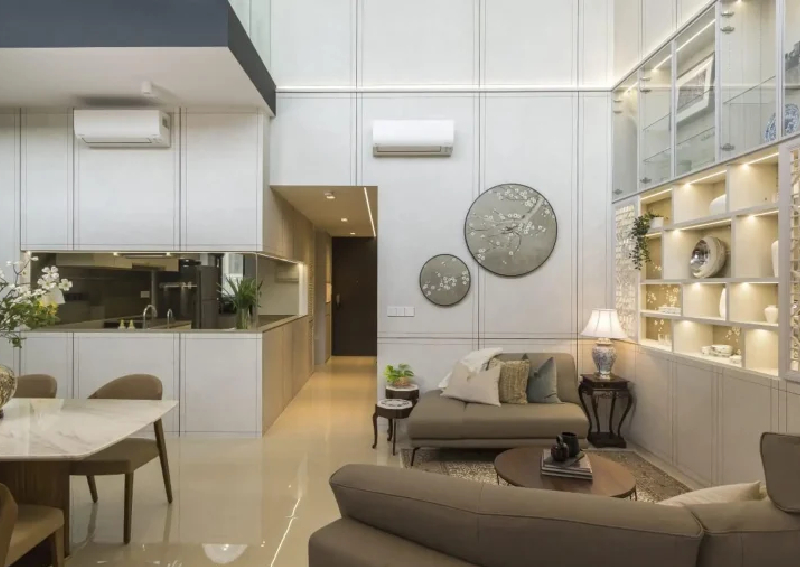
The living room also features a sofa from Nicoline - a unique curved, asymmetrical piece that is essentially a two-seater and three-seater unit. The owners enjoy hosting and wanted a cosy space for people to chat. The matching carpet under the soda is of Turkish origin and made of handmade cashmere.
For the dining area, a large eight-seater table with fluted legs is the centrepiece. The tabletop is white marble, for better light reflection to brighten the place. Lights are positioned at a height of three metres, which ensures they're reachable by ladder. Due to the height of the ceiling, it was decided not to hang anything from it, for ease of maintenance.
The balcony is spacious two metres by five metres, allowing for an outdoor lounger. A quartz six-seater table is good for drinks at night, and the unit has a pool view.
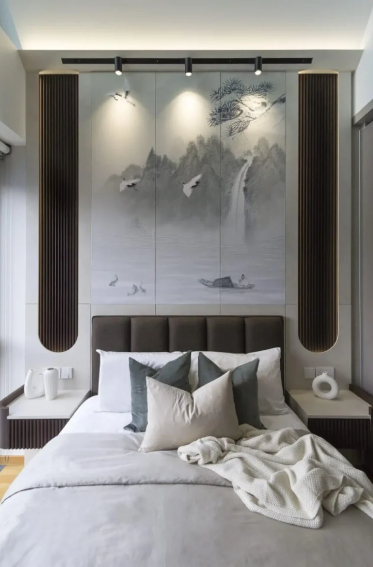
The first bedroom/study is a flexible room that's large enough to serve as a bedroom, which can be used by the owners' visiting parents. The work table and racks are all movable, to make space as needed. The second bedroom, which is attached to a common toilet, features wall panels that alternate between fluted panels and Chinese-style landscape paintings.
The Master Bedroom is described as "the most complex room," and it's fully wallpapered with Chinese landscape scenes. This is also a high-ceiling room, but as with the dining room, all the lights and fans are situated low enough to be accessed via a ladder.
The stairs have custom-built lights along the railing, which allows the area to be illuminated without hanging light fixtures from the high ceiling. The owners handpicked monkey lights to give the area a more natural vibe, without clashing with the chinoiserie theme.
Given the size of the unit, it's not surprising that the renovation and furnishing took a while. The owners said it took around a month to plan, but three months to find the various furnishings and refine the plan. Renovations only began afterwards, which took around four months.
However, the owners noted that the process was enjoyable, as their Interior Designer provided good creative input and could grasp the balance between aesthetics and functionality. He was also willing to make changes as and when something that looked better was found. So despite the fairly long process, the flexibility of the designer kept the owners interested.
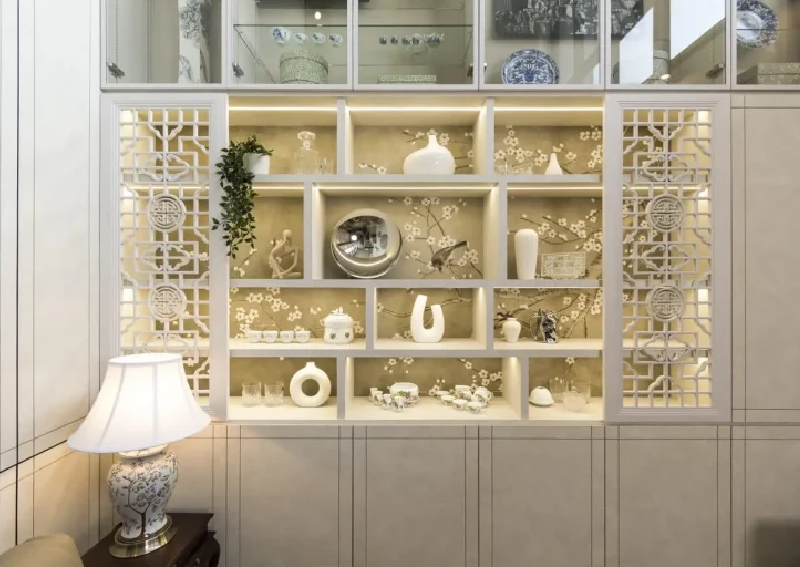
The owner's advice, if you also have a double volume unit, is to interview "as many Interior Designers as you can," to get a feel for one who "gets" what you want. Ideally, you want someone on the same page as you, so you can have fun in the process.
It's also best to set a theme and stick to it, and have your designer help hold you to it. You can find inspiration by looking online, in stores, hotels, etc. for similar themes in units with high ceilings; try to tag and revisit them daily, and cut out the ones you find you get tired of.
ALSO READ: HDB maisonette guide: 5 things to consider before buying executive maisonettes
This article was first published in Stackedhomes.